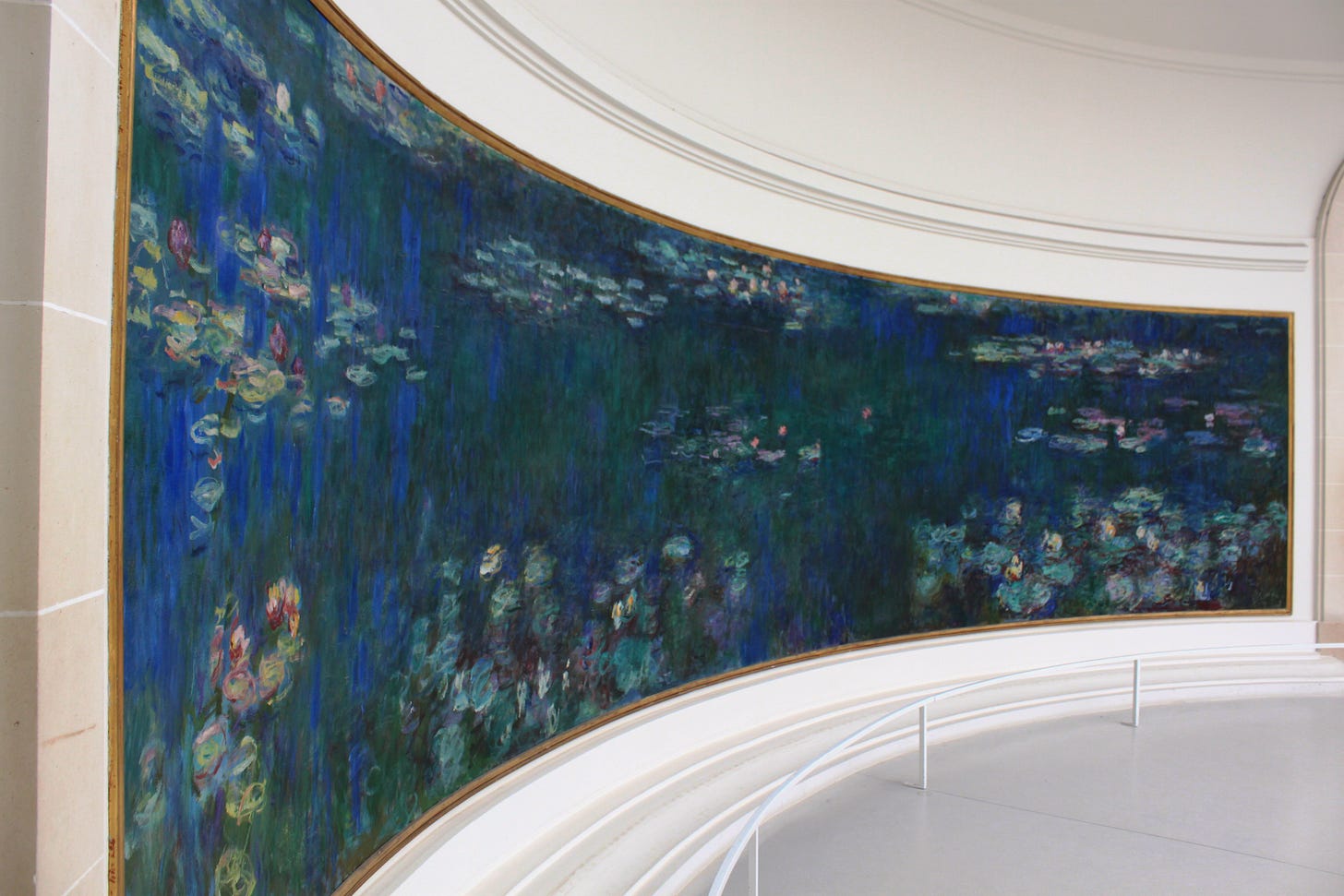On People Taking Selfies in Front of Monet's Water Lilies
and Not in Front of Emily Dickinson's Poems
As I mentioned a couple of weeks ago, Leigh and I went to Paris on holiday.
One of the main things we wanted to do was visit the Musée de l’Orangerie and take a good look at Monet’s ‘Water Lilies’.
In recent years, I’ve thought a lot about Monet. How radical and sympathetic was his way of seeing; how merely fridge magnet he can seem now. I wanted a good look at his biggest work.
After our morning at l’Orangerie, we another day took the train out to see Monet’s water garden in Giverny.
In Paris, the two large oval galleries walled with Monet’s not-panorama, had been full of people. The garden and house and studio/gift shop were, too. But because it was outdoors, and a blowy day with high white clouds, it didn’t feel as oppressive.
What I’m going to say next isn’t just a grouch. It’s something I was genuinely fascinated by, at the same time as being annoyed.
There have been recent reports of overtourism at various sites round Europe. And I’m not pretending I wasn’t there as a tourist, too.
But there were numbers of people in those two Monet shrines who were mainly there to take selfies, or to have someone take their photo, in front of the paintings.
They spent a great deal more time with their backs to the canvases than looking at them.
And what time wasn’t spent posing was spent going through the resulting images and deciding whether or not they were adequate.
What really struck me, though, as it hasn’t elsewhere, was how beautifully staged these selfies were. A specific image was being sought, artistically.
The facial expression of the supposed viewer was crucial. They each put on a look of complete aesthetic transportation, in semi-profile. At that moment, they were attempting to look unaware of being observed, in the most fetching possible way.
Then they’d snap out of their trance, step away, and look down at the screen.
No, no, yes.
And they’d move on to the next vista.
Of course, this was distracting. Leigh and I came away feeling we hadn’t really seen the paintings, and that we’d like to go back very first thing in the morning.
This wasn’t like the five hundred person scrum in front of the Mona Lisa, which we also walked past. That we’d expected, and had gone more for the nearby paintings. And, yes, we too were part of the crowd.
What this all made me think was very simple. How wonderful it is that I or you can open up a book — Emily Dickinson’s poems, say — and I or you can read —
Because I could not stop for Death –
He kindly stopped for me –
The Carriage held but just Ourselves –
And Immortality.
We slowly drove – He knew no haste
And I had put away
My labor and my leisure too,
For His Civility –
We passed the School, where Children strove
At Recess – in the Ring –
We passed the Fields of Gazing Grain –
We passed the Setting Sun –
Or rather – He passed Us –
The Dews drew quivering and Chill –
For only Gossamer, my Gown –
My Tippet – only Tulle –
We paused before a House that seemed
A Swelling of the Ground –
The Roof was scarcely visible –
The Cornice – in the Ground –
Since then – 'tis Centuries – and yet
Feels shorter than the Day
I first surmised the Horses' Heads
Were toward Eternity –
And there is no-one standing between me or you and the words.
No-one can possibly stand there distractingly posing for a selfie.
Almost immediately, though, I began to critique this thought.
How naive.
Of course it’s possible for shadow forms or very real living and dead people to come between us and what we read.
With The Iliad, which I’ve just finished listening to, it’s the translator, Samuel Butler, it’s the narrator John Lescault, it’s a long complex oral and textual history, it’s a whole culture of reception and value dominating my embedded reactions.
But then I went back to the original uninterrupted view.
Those are the words Emily Dickinson wrote.
With books, with texts, we have the possibility — perhaps phantom — of immediate proximity.
Especially if we learn the words by heart.
If there are ghosts, we can strive to clarify them.
A rain bent copy of DH Lawrence’s Women in Love, picked up from the garden wall outside someone’s soon-to-be-vacated house — that’s as nakedly Women in Love as anyone is going to get.
And if anyone’s going to interrupt your view of it, it’ll be yourself — striking an attitude, finding your best side.
I still find that a wonder.




I recall traveling to Paris before cell phones… yes, we had cameras, and we followed “no flash allowed”…. So we took photos….but not of ourselves.
I find our current state of world abysmal.
This is absolutely true. So many works of art now have been lost in this way.